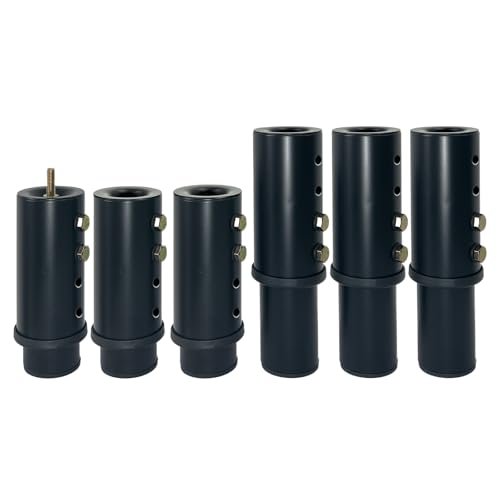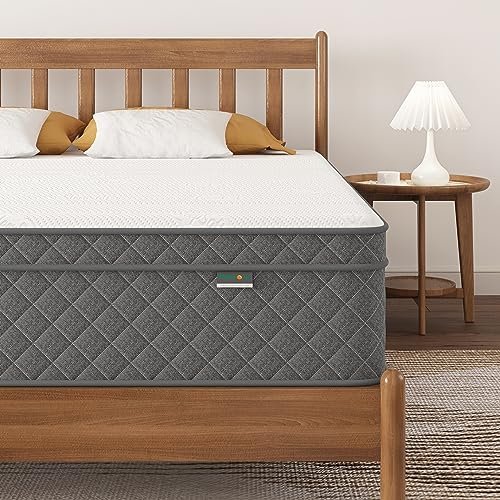The allure of an adjustable bed base is undeniable. Imagine reading in bed with your head perfectly propped up, alleviating snoring with a slight incline, or easing tired legs after a long day. It’s a game-changer for sleep and relaxation! But if you already love your beautiful bed frame, a common question pops up: “Can I use an adjustable base with my existing bed frame?”
The good news is, for most people, the answer is a resounding YES! You can absolutely integrate an adjustable base into your beloved bed frame. This guide will walk you through everything you need to know, from checking compatibility to step-by-step installation, ensuring you can enjoy the best of both worlds: the aesthetic appeal of your frame and the personalized comfort of an adjustable base.
Recommended Product:
The Big Question: Can Your Bed Frame Handle an Adjustable Base?
Before you dive into the exciting world of adjustable comfort, it’s crucial to understand what makes a bed frame compatible. Think of your adjustable base as a sophisticated, self-contained unit that replaces your traditional box spring or foundation. It needs to fit inside your bed frame, much like a mattress would, but with enough clearance to operate freely.
Here’s the essential compatibility checklist:
- Internal Dimensions: This is the most critical factor. Your bed frame’s internal width and length must be slightly larger than your adjustable base. Adjustable bases are built to standard mattress sizes (Twin, Twin XL, Full, Queen, King, Cal King), so your frame needs to match that size precisely. Measure the inside of your bed frame from rail to rail (width) and from head to foot (length). This measurement should be equal to or slightly larger (by no more than an inch or two) than your adjustable base’s dimensions.
- Support System (or Lack Thereof): This is a key point of confusion. An adjustable base does not need, and generally should not use, the slats or cross supports of your existing bed frame. The adjustable base is designed to be fully self-supporting, with its own legs that bear the weight of the base, mattress, and sleepers. Any existing slats or support systems must be removed from your bed frame to make space for the adjustable base to sit directly on the floor (or its own legs).
- Headboard and Footboard Attachment: If your bed frame has a headboard and/or footboard, you’ll want to ensure they can either attach directly to the adjustable base (many modern bases come with universal headboard brackets) or that the adjustable base can simply sit within the frame, allowing the headboard/footboard to remain aesthetically pleasing.
- Side Rail Strength and Height: Your bed frame’s side rails need to be sturdy enough to contain the adjustable base and mattress, preventing them from shifting. The height of the rails is also important – you don’t want the adjustable base or mattress to sit too high or too low for your liking.
What Kind of Bed Frames Work Best with Adjustable Bases?
While many frames can work, some are inherently more compatible than others:
- Platform Beds (with slats removed): Excellent compatibility! Platform beds are designed for mattresses to sit directly on them, often with slats. Once you remove all existing slats and center supports, the adjustable base can drop right into the cavity. This is often the cleanest look.
- Standard Bed Frames (with side rails, headboard, footboard): Generally very compatible. These frames are designed to hold a box spring and mattress. As long as you remove all cross-slats and center supports, the adjustable base will sit inside the frame, allowing you to keep your headboard and footboard. Many adjustable bases offer universal headboard brackets to secure your headboard directly to the base.
- Sleigh Beds, Poster Beds, Canopy Beds: Usually compatible, but pay close attention to the internal dimensions and the strength of the side rails. These decorative frames often have robust side rails that can easily contain an adjustable base. Again, remove all internal support structures.
- Metal Bed Frames: Often compatible, especially if they are open at the top and bottom. Check for any internal crossbars that might obstruct the adjustable base’s movement or placement.
- Storage Beds (with drawers or lift mechanisms): This can be tricky and often incompatible. Storage beds usually have a solid platform or intricate slat system directly beneath the mattress to accommodate drawers or lifting mechanisms. An adjustable base needs free space to move and its own legs to stand on, which usually conflicts with the internal structure of a storage bed. Proceed with extreme caution, and only if the storage components can be completely removed or are entirely separate from the mattress support area.
Frames that are typically NOT compatible:
- Waterbed Frames: These are very specific and usually have a solid, deep platform that won’t accommodate an adjustable base.
- Older Antique Frames with Fixed Support: If the internal support structure cannot be removed, it won’t work.
Step-by-Step Guide: Integrating Your Adjustable Base into Your Bed Frame
Ready to transform your sleep space? Follow these steps for a smooth integration:
Step 1: Measure, Measure, Measure! (Crucial!)
This cannot be stressed enough. Before you even think about buying or assembling your adjustable base, confirm it will fit.
Recommended Product:
- Measure the internal dimensions of your bed frame:
- Internal Width: Measure from the inside edge of one side rail to the inside edge of the opposite side rail.
- Internal Length: Measure from the inside edge of the headboard rail to the inside edge of the footboard rail.
- Compare these to the dimensions of the adjustable base you plan to purchase. The adjustable base should fit snugly but not be forced. A slight gap (up to an inch on each side) is generally acceptable, as it allows for minor adjustments and movement.
Step 2: Clear the Area and Disassemble Existing Support
- Remove your mattress and any existing box spring/foundation from your current bed frame.
- Carefully remove all existing slats, crossbars, and center support legs from your bed frame. You want an empty cavity for your adjustable base to sit within. Keep these parts stored safely if you ever plan to revert to a traditional setup.
- If your bed frame has a footboard, ensure there’s enough space for the adjustable base to move without hitting it when inclining.
Step 3: Assemble the Adjustable Base (Outside the Frame, First!)
- Follow the manufacturer’s instructions for assembling your adjustable base. This typically involves attaching the legs and any headboard brackets.
- It’s often easier to assemble the base outside the bed frame first, especially if it’s a larger size.
Step 4: Position the Adjustable Base Inside Your Bed Frame
- With the adjustable base assembled (or partially assembled, if it’s a split king/queen), carefully lift and place it into the empty cavity of your bed frame.
- Ensure it’s centered and that there’s adequate clearance around all sides for the base to move freely when adjusting. You don’t want the mechanism scraping against your bed frame rails.
- If you have a split adjustable base (common for King/California King and some Queen sizes), place both units side-by-side inside the frame.
Step 5: Attach Headboard (Optional, but Recommended for Stability)
- If your adjustable base came with universal headboard brackets and your headboard is compatible, now is the time to attach your headboard directly to the adjustable base. This provides stability and prevents your headboard from rattling or moving independently.
- If your headboard attaches to the bed frame, ensure it remains stable and doesn’t interfere with the adjustable base’s movement.
Step 6: Place Your Mattress and Test
- Carefully place your mattress onto the adjustable base. Most adjustable bases have retainer bars at the foot of the bed to keep the mattress from sliding off when inclined.
- Plug in your adjustable base and test all functions (head up, foot up, massage if applicable). Watch for any obstructions or areas where the base might be hitting your bed frame. Make adjustments if necessary.
- Once everything is functioning smoothly, enjoy your new, personalized comfort!
Important Considerations & Tips for Success
- Mattress Compatibility: While not directly about your bed frame, ensure your mattress is compatible with an adjustable base. Most foam, latex, and many hybrid mattresses are, but traditional innerspring mattresses may not be. Check your mattress warranty!
- Weight Capacity: An adjustable base holds the weight of the mattress and sleepers. Ensure your bed frame is sturdy enough to contain this combined weight. While the adjustable base itself is self-supporting, a flimsy bed frame could warp or break.
- Ground Clearance and Leg Height: Adjustable bases come with legs of varying heights. Consider the overall height once your mattress is on top. You may want to ensure the base’s legs are short enough that the base sits neatly within your frame, without too much of a gap between the bottom of your mattress and the top of your side rails.
- Split King/Queen Bases: For larger sizes, adjustable bases often come as two separate units (e.g., two Twin XLs for a King). Make sure your bed frame has enough internal space for both units, and consider a “split” mattress for individualized adjustment on each side.
- Aesthetics and Gaps: Depending on the design of your bed frame and adjustable base, you might have small gaps between the base and the frame’s side rails. This is usually not an issue for functionality but something to be aware of for aesthetics. You can sometimes use gap fillers or even strategically placed foam to mitigate this.
- Professional Help: If your bed frame is particularly heavy or complex, or if you’re unsure about the installation, consider hiring movers or a handyman for assistance. Safety first!
Common Mistakes to Avoid
- Not Measuring Accurately: This is the #1 mistake. Don’t assume standard sizes are always exact. Always measure the internal dimensions of your frame.
- Leaving Existing Slats or Support: The adjustable base is designed to be completely self-supporting. Leaving slats in place can hinder the base’s movement, damage its motors, or even void its warranty. Remove them!
- Ignoring Clearance: Forgetting that an adjustable base needs room to move (especially the head and foot sections) can lead to frustrating scraping, damage to your bed frame, or restricted movement.
- Overlooking Mattress Compatibility: A traditional spring mattress on an adjustable base can lead to discomfort, damage the mattress, and reduce the effectiveness of the base.
- Forcing the Fit: If your adjustable base doesn’t fit easily into your frame, do not force it. This can damage both the base and your frame. Recheck measurements or consider a different approach.
- Not Considering Overall Height: An adjustable base and mattress can sit significantly higher than a traditional box spring and mattress, especially if your frame has deep side rails. Plan accordingly for your desired bed height.
Conclusion
Integrating an adjustable base into your existing bed frame is a fantastic way to upgrade your sleep experience without sacrificing the look of your bedroom. By carefully measuring, understanding compatibility, and following the right steps, you can confidently combine the aesthetic appeal of your cherished bed frame with the unparalleled comfort and health benefits of an adjustable base.
So, go ahead – take those measurements, make the switch, and prepare to enjoy a whole new level of personalized relaxation and sleep. Your perfect night’s rest is just a few adjustments away!
Recommended Product:
FAQ
Q. Can I generally use an adjustable base with my existing bed frame?
A. Yes, in many cases, an adjustable base can be placed inside an existing bed frame. The key is ensuring your bed frame has the right structure and internal dimensions to accommodate the adjustable unit, which acts as its own foundation and support system.
Q. What types of bed frames are usually compatible with an adjustable base?
A. Platform bed frames, slat bed frames with sturdy side rails, and many standard metal bed frames (especially those designed for a box spring) are often compatible. Frames that allow the adjustable base to sit directly on the floor or on robust support rails within the frame are ideal.
Q. Which bed frames are typically NOT suitable for use with an adjustable base?
A. Sleigh beds, antique frames with delicate or integrated support systems, some poster beds where the frame itself provides rigid mattress support, waterbed frames, and bed frames that only consist of a headboard and footboard without sturdy side rails are generally not compatible. Frames with shallow side rails or complex internal structures can also pose issues.
Q. What internal measurements are critical to check before purchasing an adjustable base for my frame?
A. You need to precisely measure the inside length and width of your bed frame (from inner edge to inner edge of the side rails) to ensure the adjustable base will fit snugly without being too tight or too loose. Also, consider the height of your bed frame’s side rails and the adjustable base itself for aesthetic and functional clearance.
Q. Do I need to remove my bed frame’s existing slats or support system?
A. Yes, almost always. The adjustable base functions as its own complete support system. You should remove all existing slats, cross beams, or any other foundation supports from your bed frame to allow the adjustable base to sit either on the floor within the frame or on the frame’s side rails directly.
Q. How does an adjustable base typically fit inside a bed frame?
A. An adjustable base is designed to function as a standalone unit. When used with a decorative bed frame, it usually sits inside the perimeter of the frame, replacing the traditional box spring or foundation. Most adjustable bases have legs that sit on the floor, while some are designed to sit directly on the frame’s internal side rails, if sturdy enough.
Q. Will my headboard and footboard still be secure and stable with an adjustable base?
A. Your headboard and footboard should remain secure if they are properly attached to the bed frame’s side rails. Many adjustable bases offer optional headboard brackets that can attach directly to the base itself, allowing you to secure your headboard even if the base isn’t directly connected to the original frame’s headboard mounts. Footboards are generally decorative and don’t affect the adjustable base’s function.
Q. Are there any weight considerations when pairing an adjustable base with a bed frame?
A. Yes, while the adjustable base itself is self-supporting, ensure your bed frame’s side rails are robust enough to withstand any lateral pressure or accidental bumps. The adjustable base’s own weight capacity will be the primary factor for supporting the mattress and occupants, not the decorative bed frame itself.
Q. What if my bed frame doesn’t have sturdy side rails or a full perimeter?
A. If your bed frame only consists of a headboard and footboard with minimal or no sturdy side rails, it’s generally not suitable. An adjustable base needs a stable perimeter to sit within to prevent it from shifting. In such cases, the bed frame would primarily be decorative, and you’d rely entirely on the adjustable base for support, which often means the bed frame isn’t truly integrated.
Q. Can I use any mattress with an adjustable base inside my bed frame?
A. Not all mattresses are compatible. Memory foam, latex, and many hybrid mattresses are ideal for adjustable bases due to their flexibility. Traditional innerspring mattresses, particularly those with a continuous coil system, are generally not designed to bend and may be damaged or become uncomfortable if used with an adjustable base. Always check your mattress warranty and manufacturer recommendations for compatibility.




